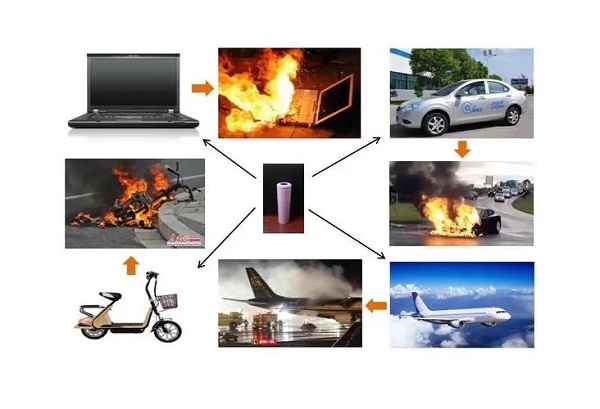The advantage of new energy vehicles is that they are more low-carbon and environmentally friendly than gasoline-fueled vehicles. It uses unconventional vehicle fuels as its power source, such as lithium batteries, hydrogen fuel, etc. Lithium-ion batteries are also used in a wide range of applications, including new energy vehicles, mobile phones, laptops, tablets, mobile power supplies, electric bicycles, power tools, etc.
 However,
the safety issues of lithium-ion batteries cannot be underestimated.
Many accidents have shown that when people charge improperly or the
ambient temperature is too high, it is very easy to cause spontaneous
combustion and explosion of lithium-ion batteries. This has also become
the biggest pain point in the development process of lithium-ion
batteries.
However,
the safety issues of lithium-ion batteries cannot be underestimated.
Many accidents have shown that when people charge improperly or the
ambient temperature is too high, it is very easy to cause spontaneous
combustion and explosion of lithium-ion batteries. This has also become
the biggest pain point in the development process of lithium-ion
batteries.
Although the properties of lithium batteries
themselves determine their fate of being "flammable and explosive", it
is not completely impossible to reduce risks and safety. With the
continuous advancement of battery technology, whether it is a mobile
phone company or a new energy vehicle company, through reasonable
battery management systems and thermal management systems, batteries can
ensure safety and will not explode or spontaneously ignite.
1. Improve the safety of electrolyte
There
is a high reactivity between the electrolyte and the positive and
negative electrodes, especially at high temperatures. In order to
improve the safety of the battery, improving the safety of the
electrolyte is one of the more effective methods. The potential safety
hazards of the electrolyte can be effectively solved by adding
functional additives, using new lithium salts, and using new solvents.
According
to the different functions of additives, they can be mainly divided
into the following categories: safety protection additives, film-forming
additives, cathode protection additives, stabilizing lithium salt
additives, lithium precipitation-promoting additives, current collector
anti-corrosion additives, wettability-enhancing additives, etc.
2. Improve the safety of electrode materials
Lithium iron phosphate
and ternary composite materials are considered to be low-cost,
"excellent safety" cathode materials and may be widely used in the
electric vehicle industry. For positive electrode materials, a common
method to improve their safety is coating modification. For example,
surface coating of the positive electrode material with metal oxide can
prevent direct contact between the positive electrode material and the
electrolyte, inhibit the phase change of the positive electrode
material, and improve the safety of the positive electrode material. Its
structural stability reduces the disorder of cations in the crystal
lattice to reduce the heat generated by side reactions.
As
for the anode material, since its surface is often the part in the
lithium-ion battery that is most prone to thermochemical decomposition
and heat release, improving the thermal stability of the SEI film is a
key method to improve the safety of the anode material. The thermal
stability of negative electrode materials can be improved through weak
oxidation, metal and metal oxide deposition, polymer or carbon coating.
3. Improve battery safety protection design
In
addition to improving the safety of battery materials, commercial
lithium-ion batteries adopt many safety protection measures, such as
setting up battery safety valves, hot-melt fuses, connecting components
with positive temperature coefficients in series, using thermally sealed
diaphragms, loading special protection circuits, and special battery
management systems, etc., are also means to enhance security.
BENZO Energy Technology Co.,Ltd
UFine Technology Co., Ltd
![]() TEL: +86-755-84822012
TEL: +86-755-84822012
![]() TEL: +86-13538185686
TEL: +86-13538185686
![]() Email: contact@benzoenergy.com
Email: contact@benzoenergy.com
![]() Email: sales02@benzoenergy.com
Email: sales02@benzoenergy.com
![]() Email: sales03@benzoenergy.com
Email: sales03@benzoenergy.com
![]() Email: sales01@benzoenergy.com
Email: sales01@benzoenergy.com
![]() Skype: benzobattery1231@gmail.com
Skype: benzobattery1231@gmail.com
![]() Office Address:Building C1, Bantian International Center, BanTian Street, Longgang area, Shenzhen City, China
Office Address:Building C1, Bantian International Center, BanTian Street, Longgang area, Shenzhen City, China
![]() Factory Address 1: Luoma Second Bridge, Tiansheng Lake Villager Group, Luoma Village, QingXi Town, DongGuan, China
Factory Address 1: Luoma Second Bridge, Tiansheng Lake Villager Group, Luoma Village, QingXi Town, DongGuan, China
![]() Factory Address 2: Building
41, Zhongnan HighTech Rongzhi Chuangmei Industrial Valley, Siqian Town,
Xinhui District, Jiangmen City, Guangdong, China
Factory Address 2: Building
41, Zhongnan HighTech Rongzhi Chuangmei Industrial Valley, Siqian Town,
Xinhui District, Jiangmen City, Guangdong, China
Site: www.bz-battery.com / www.benzoenergy.com
Comments
Post a Comment